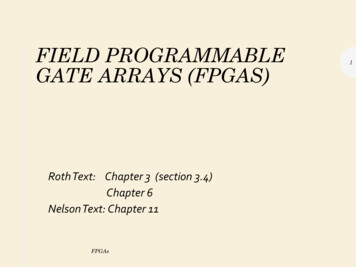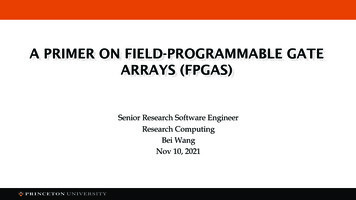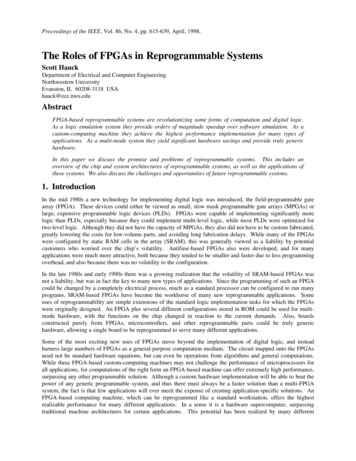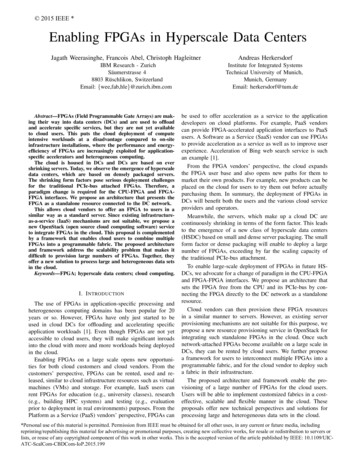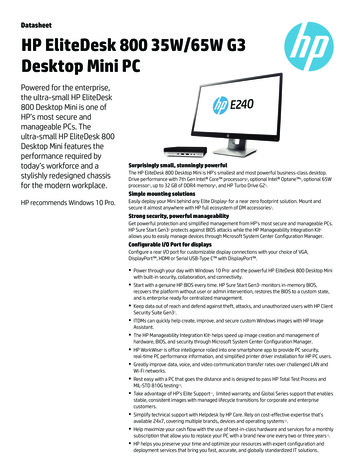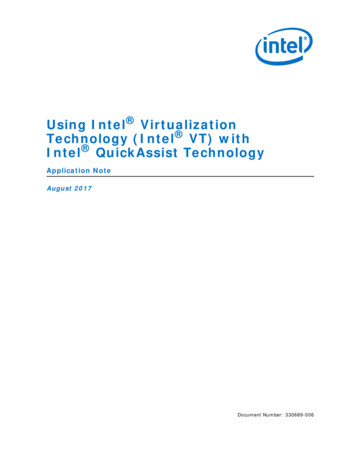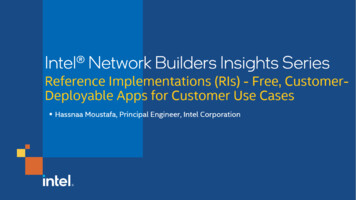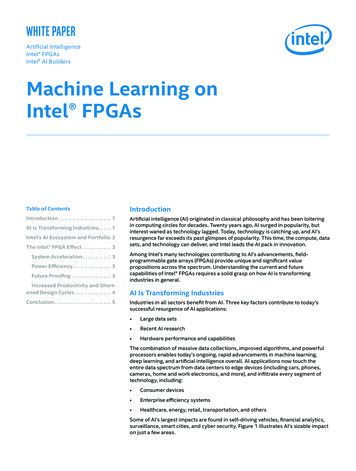
Transcription
white paperArtificial IntelligenceIntel FPGAsIntel AI BuildersMachine Learning onIntel FPGAsTable of ContentsIntroductionIntroduction . . . . . . . . . . . . . . . . . . . . . 1Artificial intelligence (AI) originated in classical philosophy and has been loiteringin computing circles for decades. Twenty years ago, AI surged in popularity, butinterest waned as technology lagged. Today, technology is catching up, and AI’sresurgence far exceeds its past glimpses of popularity. This time, the compute, datasets, and technology can deliver, and Intel leads the AI pack in innovation.AI Is Transforming Industries. . . . . . 1Intel’s AI Ecosystem and Portfolio.2The Intel FPGA Effect . . . . . . . . . . . . 3System Acceleration. . . . . . . . . . . . 3Power Efficiency. . . . . . . . . . . . . . . . 3Future Proofing . . . . . . . . . . . . . . . . 3Increased Productivity and Shortened Design Cycles. . . . . . . . . . . . . . . 4Conclusion. . . . . . . . . . . . . . . . . . . . . . . 5Among Intel’s many technologies contributing to AI’s advancements, fieldprogrammable gate arrays (FPGAs) provide unique and significant valuepropositions across the spectrum. Understanding the current and futurecapabilities of Intel FPGAs requires a solid grasp on how AI is transformingindustries in general.AI Is Transforming IndustriesIndustries in all sectors benefit from AI. Three key factors contribute to today’ssuccessful resurgence of AI applications: Large data sets Recent AI research Hardware performance and capabilitiesThe combination of massive data collections, improved algorithms, and powerfulprocessors enables today’s ongoing, rapid advancements in machine learning,deep learning, and artificial intelligence overall. AI applications now touch theentire data spectrum from data centers to edge devices (including cars, phones,cameras, home and work electronics, and more), and infiltrate every segment oftechnology, including: Consumer devices Enterprise efficiency systems Healthcare, energy, retail, transportation, and othersSome of AI’s largest impacts are found in self-driving vehicles, financial analytics,surveillance, smart cities, and cyber security. Figure 1 illustrates AI’s sizable impacton just a few areas.
White Paper Machine Learning on Intel FPGAsFigure 1. Examples of how AI is transforming industries.To support AI’s growth today and well into the future, Intel provides a range of AI products in its AI ecosystem. Intel FPGAsare a key component in this ecosystem.Intel’s AI Ecosystem and PortfolioAs a technology leader, Intel offers a complete AI ecosystem that concentrates far beyond today’s AI—Intel is committedto fueling the AI revolution deep into the future. It’s a top priority for Intel, as demonstrated through in-house research,development, and key acquisitions. FPGAs play an important role in this commitment.Intel’s comprehensive, flexible, and performance-optimized AI portfolio of products for machine and deep learning covers theentire spectrum from hardware platforms to end user applications, as shown in Figure 2, including: Intel Math Kernel Library for Deep Neural Networks (Intel MKL-DNN) Compute Library for Deep Neural Networks Deep Learning Accelerator Library for FPGAs Frameworks such as Caffe* and TensorFlow* Tools like the Deep Learning Deployment Toolkit from IntelFigure 2. Intel’s AI Portfolio of products for machine and deep learning.Overall, Intel provides a unified front end for the broad variety of backend hardware platforms, enabling users to develop asystem with one device today and seamlessly switch to a newer, different hardware platform tomorrow. This comprehensive2
White Paper Machine Learning on Intel FPGAsnature of the Intel’s AI Ecosystem and portfolio means Intel is uniquely situated to help developers at all levels access the fullcapacity of Intel hardware platforms, both current and future. This approach empowers hardware and software developers totake advantage of the FPGAs’ capabilities with machine learning, leading to increased productivity and shorter design cycles.The Intel FPGA EffectIntel FPGAs offer unique value propositions, and they are now enabled for Intel’s AI ecosystem. Intel FPGAs provide excellentsystem acceleration with deterministic low latency, power efficiency, and future proofing, as illustrated in Figure 3.Figure 3. Intel FPGAs offer unique value propositions for AI.System AccelerationToday, people are looking for ways to leverage CPU and GPU architectures to get more total operations processing out ofthem, which helps with compute performance. FPGAs are concerned with system performance. Intel FPGAs accelerateand aid the compute and connectivity required to collect and process the massive quantities of information around us bycontrolling the data path. In addition to FPGAs being used as compute offload, they can also directly receive data and processit inline without going through the host system. This frees the processor to manage other system events and provide higherreal time system performance.Real time is key. AI often relies on real-time processing to draw instantaneous conclusions and respond accurately. Imaginea self-driving car waiting for feedback after another car breaks hard or a deer leaps from the bushes. Immediacy has been achallenge given the amount of data involved, and lag can mean the difference between responding to an event and missing itentirely.FPGAs’ flexibility enables them to deliver deterministic low latency (the guaranteed upper limit on the amount of timebetween a message sent and received under all system conditions) and high bandwidth. This flexibility supports the creationof custom hardware for individual solutions in an optimal way. Regardless of the custom or standard data interface, topology,or precision requirement, an FPGA can implement the exact architecture defined, which allows for unique solutions and fixeddata paths. This also equates to excellent power efficiency and future proofing.Power EfficiencyFPGAs’ ability to create custom solutions means they can create power-efficient solutions. They enable the creation ofsolutions that address specific problems, in the way each problem needs to be solved, by removing individual bottlenecks inthe computation, not by pushing solutions through fixed architectures.Intel FPGAs have over 8 TB/s of on-die memory bandwidth. Therefore, solutions tend to keep the data on the device tightlycoupled with the next compute. This minimizes the need to access external memory, which results in running at significantlylower frequencies. These lower frequencies and efficient compute implementations result in very powerful and efficientsolutions. For example, FPGAs show up to an 80% power reduction when using AlexNet* (a convolutional neural network)compared to CPUs.Future ProofingIn addition to system acceleration and power efficiency, Intel FPGAs help future proof systems. With such a dynamictechnology as machine learning, which is evolving and changing constantly, Intel FPGAs provide the flexibility unavailable infixed devices. As precisions drop from 32-bit to 8-bit and even binary/ternary networks, an FPGA has the flexibility to supportthose changes instantly. As next generation architectures and methodologies are developed, FPGAs will be there to implementthem. By reprogramming an FPGA’s image, its functionality can be changed completely. Dedicated ASICs can provide a higher3
White Paper Machine Learning on Intel FPGAstotal cost of ownership (TCO) in the long run, and with such a dynamic technology, there is a higher and higher threshold towarrant building them, especially if FPGAs can meet a system’s needs.Some markets demand longevity and high reliability from hardware with systems being deployed for 5, 10, 15, or moreyears in harsh environments. For example, imagine putting smart cameras on the street or compute systems in automobilesand requiring the same 18 month refresh cycle that CPUs and GPUs expect. The FPGAs flexibility enables users to updatethe hardware capabilities for the system without requiring a hardware refresh. This results in longer lifespans of deployedproducts. FPGAs have a history of long production cycles with devices being built for well over 15 to 20 years. They have beenused in space, military, and extremely high reliability environments for decades.For these reasons and more, developers at all levels need to understand how the Intel’s AI Ecosystem and portfolio employsIntel FPGAs. This knowledge will enable developers to use Intel FPGAs to accelerate and extend the life and efficiency of AIapplications.Increased Productivity and Shortened Design CyclesMost developers know FPGAs are flexible and robust devices providing a wide variety of uses: FPGAs can become any digital circuit as long as the unit has enough logic blocks to implement that circuit. Their flexible platform enables custom system architectures that other devices simply cannot efficiently support. FPGAs can perform inline data processing, such as machine learning, from a video camera or Ethernet stream, forexample, and then pass the results to a storage device or to the process for further processing. FPGAs can do this whilesimultaneously performing, in parallel, compute offload.But not all developers know how to access Intel FPGAs’ potential or that they can do so with shorter-than-ever design cycles(illustrated in Figure 4).Figure 4. Intel’s AI ecosystem is now enabled for FPGA.To help developers bring FPGAs to market running machine learning workloads, Intel has shortened the design time fordevelopers by creating a set of API layers. Developers can interface with the API layers based on their level of expertise, asoutlined in Figure 5.Figure 5. Four Entry Points for Developers4
White Paper Machine Learning on Intel FPGAsTypical users can start at the SDK or framework level. More advanced users, who want to build their own software stack, canenter at the Software API layer. The Software API layer abstracts away the lower-level OpenCL runtime and is the same APIthe libraries use. Customers who want to build their own software stack can enter at the C Embedded API Layer. Advancedplatform developers who want to add more than machine learning to their FPGA—such as support for asynchronous parallelcompute offload functions or modified source code—can enter in at the OpenCL Host Runtime API level or the Intel DeepLearning Architecture Library level, if they want to customize the machine learning library.Several design entry methods are available for power users looking to modify source code and customize the topology byadding custom primitives. Developers can customize their solutions by using traditional RTL (Verilog or VHDL), which iscommon for FPGA developers, or the higher level compute languages, such as C/C or OpenCL . By offering these variousentry points for developers, Intel makes implementing FPGAs accessible for various skillsets in a timely manner.ConclusionIntel is uniquely positioned for AI development—the Intel’s AI Ecosystem offers solutions for all aspects of AI by providinga unified front end for a variety of backend technologies, from hardware to edge devices. In addition, Intel’s ecosystem isnow fully enabled for FPGA. Intel FPGAs provide numerous benefits, including system acceleration opportunities, powerefficiency, and future proofing, due to FPGAs’ long lifespans, flexibility, and re-configurability. Finally, to help propel AI todayand into the future, Intel AI solutions allow a variety of language-agnostic entry points for developers at all skillset levels.Optimization NoticeIntel's Compilers may or may not optimize to the same degree for non-Intel microprocessors for optimizations that are not unique to Intel microprocessors. These optimization include SSE2,SSE3, and SSSE3 instruction sets and other optimizations. Intel does not guarantee the availability, functionality, or effectiveness of any optimization on microprocessors not manufactured byIntel. Microprocessors-dependent optimizations in this product are intended to use with Intel microprocessors. Certain optimizations not specific to Intel microarchitecture are reserved for Intelmicroprocessors. Please refer to the applicable product User and Reference Guide for more information regarding specific instruction sets covered by this notice.Notice revision #20110804DisclaimersSoftware and workloads used in performance tests may have been optimized for performance only on Intel microprocessors.Performance tests, such as SYSmark and MobileMark, are measured using specific computer systems, components, software, operations and functions. Any change to any of those factors maycause the results to vary. You should consult other information and performance tests to assist you in fully evaluating your contemplated purchases, including the performance of that productwhen combined with other products. For more complete information visit www.intel.com/benchmarks.Intel technologies’ features and benefits depend on system configuration and may require enabled hardware, software or service activation. Performance varies depending on systemconfiguration. No computer system can be absolutely secure. Check with your system manufacturer or retailer or learn more at intel.com.Benchmark results were obtained prior to implementation of recent software patches and firmware updates intended to address exploits referred to as “Spectre” and “Meltdown”.Implementation of these updates may make these results inapplicable to your device or system.Intel, the Intel logo, Xeon, are trademarks of Intel Corporation or its subsidiaries in the U.S. and/or other countries.*Other names and brands may be claimed as the property of others. 2018 Intel CorporationPrinted in USA0518/BA/PDFPlease Recycle5
FPGAs can become any digital circuit as long as the unit has enough logic blocks to implement that circuit. Their flexible platform enables custom system architectures that other devices simply cannot efficiently support. FPGAs can perform inline data processing, such as machine learning, from a video camera or Ethernet stream, for
